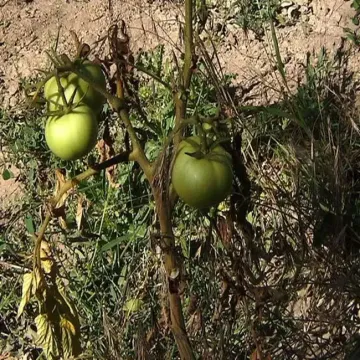Tomatoes are a popular choice for home gardeners, but even with the best care, they often start to look bedraggled by mid to late summer. If you've noticed your once lush, green tomato plants turning yellow, wilting, or showing signs of stress, you're not alone. Here’s a breakdown of the most common reasons why tomato plants start to look bad as the growing season progresses and what you can do about it.
1. Heat Stress
In many regions, mid to late summer brings intense heat, which can cause significant stress to tomato plants. Temperatures above 85°F during the day and 70°F at night can disrupt the plant's ability to produce fruit. The leaves may wilt during the hottest part of the day, and prolonged exposure to high temperatures can cause leaves to turn yellow, curl, or even develop brown, crispy edges.
Solution: To combat heat stress, consider shading your tomato plants during the hottest part of the day using shade cloths or strategically planted taller crops. Mulching can also help keep the soil cooler and retain moisture.
2. Nutrient Depletion
By mid to late summer, tomato plants have been growing and producing fruit for several months, depleting the soil of essential nutrients. Without proper fertilization, the plants may begin to show signs of nutrient deficiencies, such as yellowing leaves (nitrogen deficiency), purpling of the undersides of leaves (phosphorus deficiency), or browning edges (potassium deficiency).
Solution: Regular feeding with a balanced fertilizer or compost can replenish depleted nutrients. Be mindful of over-fertilizing, especially with nitrogen, as this can lead to excessive foliage growth at the expense of fruit production.
3. Pests
Summer is also prime time for pests like aphids, whiteflies, and spider mites to attack tomato plants. These pests can weaken the plants by sucking out the sap, causing leaves to yellow, curl, and eventually die off. Additionally, they can spread diseases that further compromise plant health.
Solution: Regularly inspect your plants for signs of pests. Introduce beneficial insects, such as ladybugs, or use organic insecticides like neem oil or insecticidal soap to control pest populations.
4. Diseases
Tomato plants are susceptible to a variety of diseases, many of which become more prominent as the summer progresses. Fungal diseases like early blight, late blight, and septoria leaf spot are common culprits, often causing yellowing, brown spots, and eventual leaf drop. Bacterial diseases, such as bacterial wilt, can also lead to wilting and plant decline.
Solution: To prevent the spread of disease, avoid overhead watering and water at the base of the plants instead. Prune lower leaves to improve air circulation, and remove any diseased leaves as soon as you spot them. Rotating crops and planting disease-resistant varieties can also reduce the likelihood of disease outbreaks.
5. Overwatering or Underwatering
Tomatoes need consistent watering to thrive, and the balance can be tricky to maintain, especially in the fluctuating temperatures of summer. Overwatering can lead to root rot and fungal issues, while underwatering can cause the plants to wilt, drop leaves, and produce cracked fruit.
Solution: Ensure your tomato plants receive about 1-2 inches of water per week, depending on your climate. Mulching helps retain soil moisture, and using a soaker hose or drip irrigation system can provide consistent, deep watering without wetting the foliage.
6. End of Life Cycle
Tomato plants are annuals, meaning they complete their life cycle in one growing season. By mid to late summer, many varieties are nearing the end of their natural lifecycle. As the plants age, they will naturally begin to decline, with yellowing leaves and reduced fruit production.
Solution: Some gardeners choose to plant a second round of tomatoes mid-summer for a fall harvest. For existing plants, continue to provide good care, but recognize that some decline is inevitable as the season progresses.
7. Heavy Fruit Production
Tomato plants put a lot of energy into producing fruit, and as the plants reach peak production, they can start to look exhausted. The leaves may yellow or drop, and the overall vigor of the plant may decline as it prioritizes fruit ripening over new growth.
Solution: Pruning some of the excess foliage can help direct the plant's energy towards the remaining fruit. Be sure to provide support to heavy-laden branches to prevent them from breaking under the weight of the fruit.
Conclusion
While it can be frustrating to see your tomato plants looking worse for wear by mid to late summer, understanding the reasons behind this decline can help you take steps to mitigate the damage. With careful attention to watering, fertilizing, and pest and disease management, you can extend the health and productivity of your tomato plants for as long as possible. But remember, some level of decline is natural as the growing season winds down. With a bit of care, you can still enjoy a bountiful tomato harvest, even if the plants themselves are starting to show their age.

